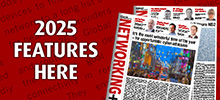30 November 2023
Ted Curtis, senior sales engineer, NETSCOUT
This is where 5G technology can help. Consider merging the expansive reach of public networks with the tailored capabilities of a private 5G network for specific sites or events and making this available to customers. CSPs can easily achieve this with the implementation of network slicing.
Assessing network slicing
Network slicing, an innovative capability of 5G networks, has attracted significant attention among service providers in recent years. As Western Europe is set to experience a projected annual growth rate of 41% in 5G subscriptions, which equates to a staggering 490 million subscriptions by 2028, the importance of network slicing in driving the growth of private 5G networks cannot be underestimated.
The technology involves splitting an individual physical network into several virtual networks, each with its own distinctive set of resources, performance characteristics, and security policies. This adaptability enables virtual networks to be optimised for specific user needs, ranging from lower latency and heightened security to high-definition video streaming and increased reliability. Network slicing supports 5G in realising its true potential when it comes to catering to individualised requirements.
However, a key challenge in adopting network slicing is effective end-to-end monitoring and management of network slices, as modern networks have become more complex. This has made network telemetry harder to obtain, leaving the majority of CSPs unaware of issues affecting customer network slices. This absence of performance visibility raises concerns among service provider customers, leaving them unsure if they're receiving the level of service they're paying for.
However, when we consider the potential revenue that network slicing can generate, the future appears promising. It is projected that network slicing could contribute as much as $300 billion to CSPs by 2025, with the market itself anticipated to experience an annual growth rate of nearly 25% from 2023-2028. For service providers embracing network slicing, the technology offers an opportunity to offset the substantial costs associated with constructing and deploying their high-speed 5G networks.
Network slicing’s use cases
Automated network slicing design empowers businesses to efficiently introduce a multitude of services, catering to both enterprise and consumer needs. This can be achieved through the utilisation of service level agreements and subscriptions, which in turn generate substantial revenue opportunities. The technology has a number of use cases, including:
Gaming
It is a well-known fact that individuals require optimal network performance when gaming, with even marginal latency improvements capable of influencing them to switch service providers. Network slicing can address this need for lower latency by offering dedicated slices for mobile and cloud gaming, upgrading the overall gaming experience. As mobile gaming’s popularity continues to go from strength to strength, alongside the emergence of cloud gaming, game developers will look for quality connectivity and visibility to troubleshoot latency issues in an efficient and effective way.
According to Uswitch, European gamers were estimated to number 430 million in 2022, with this figure projected to rise to 646 million by 2026, representing an increase of more than 50% in the number of gamers in the region. In an ever-growing market, those CSPs who use network slicing will be able to compete and attract new users.
Healthcare
In the healthcare industry, there is the potential to utilise a defined, high-reliability network slice for telerobotic surgeons, which would see a surgeon from one part of the world operate robotic systems located hundreds or even thousands of kilometres away. This will reduce patient travel burdens and expand access to specialists.
By ensuring reliable connections, lower latency, and improved bandwidth, network slicing has the capacity to elevate the resolution of digital displays surgeons deploy during such procedures. As the popularity of these remote operations grows, healthcare organisations will demand network slices are guaranteed to provide uninterrupted connectivity, with CSPs being accountable for delivering these crucial services.
Financial services
Network slicing presents opportunities to prioritise security and speed in the financial services sector. By designing mobile banking applications to be capable of directly connecting to financial institutions, users are provided with a secure, user-friendly, efficient experience. When it comes to traders and investment bankers, low-latency connections provided by network slices can have a sizeable impact on their trading operations, with each and every second determining whether they make a profit or loss.
Events
For service providers, network slicing permits unprecedented levels of flexibility in network resource allocation. This means that an operator can adequately prepare for a short-term but massive event. For instance, it would enable network operators to set aside significant resources for the World Cup final – during which traffic volumes are sizeable and continue getting larger as fans react to the event in real time – and temporarily designate the extensive resources needed to ensure the event runs smoothly for hosts, participants and viewers. Once the event is over, operators can then discard the network slice, freeing that bandwidth.
Embracing the technology
Network slicing is set to reshape the connectivity landscape in the UK and beyond, with most CSPs giving thought to incorporating this capability into their services. By providing both customisation and flexibility, it equips businesses and consumers to leverage 5G’s full potential. However, achieving successful integration requires a proactive stance from CSPs, coupled with the need for robust end-to-end monitoring capabilities to ensure accountability among stakeholders and deliver a seamless user experience.
With industries like healthcare, gaming, and events exploring the numerous opportunities presented by network slicing, the UK is on the precipice of a new era of connectivity and innovation. Embracing this transformative technology will undoubtedly support progress and thrust the nation towards an increasingly connected future.










